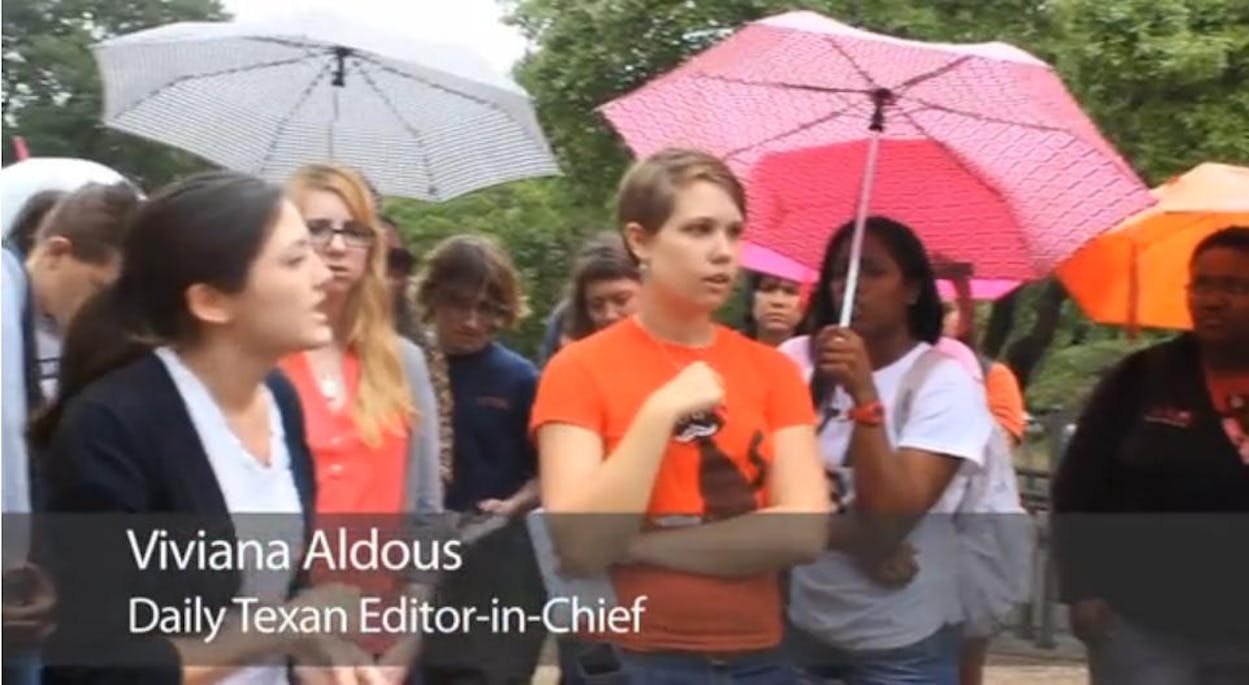In late March, the Daily Texan, published a cartoon about the Trayvon Martin shooting that called Martin a “colored boy” and claimed the media’s reporting of the shooting was a case of yellow journalism. The backlash was immediate, both locally and nationally. Students protested outside the Daily Texan‘s offices and later met with the paper’s editorial board and demanded an explanation for the cartoon.
While the paper’s leadership initially maintained that they allowed the cartoon to run because the Daily Texan‘s opinion pages are intended to be an open “forum for people across campus,” within 24 hours the editorial board began apologizing for the cartoon and announced that they would no longer publish Stephanie Eisner’s cartoons.
The Daily Texan is engaged in some self reflection, examining how issues of race and diversity on campus are covered in its pages. In the last two months, Daily Texan staffers have attended workshops and met with members of student minority organizations. And on April 25, the paper began publishing a series aimed at addressing the issues of race, racism and diversity on the UT campus. So far the Texan has published five stories in the series:
- Latino freshmen defy statistics by attending college, becoming role models
- Greek life helps unify minority students
- Malcolm X Lounge offers safe haven to students of all races
- A history of racial controversy at the Daily Texan
- Fixtures symbolize UT’s complicated racial past, present and future
While members of the Daily Texan editorial board did not respond to emails from the TM Daily Post for comment about the articles, the fourth piece touched on what the paper hopes to achieve with the series: “Hopefully, moving forward the Texan will have better coverage of the entire campus community and better representation of all of our students,” current Texan editor-in-chief Viviana Aldous said in the story.
That same piece, which looks at the Texan‘s history covering race back to the paper’s founding in 1900, acknowledges that the Trayvon Martin cartoon was “latest in a long line of incidents” of racial controversy in its pages. “These flashpoints at the Texan seem to pop up fairly frequently,” journalism professor Robert Jensen said.
For example, in 1957, the paper’s editorial board slammed the decision to give a black woman the lead female role in an opera, because she would have had to perform opposite a white male. “Even if the girl chosen had the best voice, and we do not doubt that she did, it would have seemed only the better part of discretion and wisdom not to cast her in a romantic role opposite a white male lead,” the editorial board wrote.
In 1991, the paper ran a full-page ad from the Committee for Open Debate on the Holocaust that questioned whether the Holocaust really occurred. And in 1997, after the U.S. Supreme Court in Hopwood v. Texas blocked the university from using affirmative action in its admissions process, the Texan ran an op-ed from UT Law Professor Lino Graglia in which he wrote that “blacks and Mexican-Americans are not academically competitive with whites and Asians. Racial preferences is simply an attempt to conceal or wish away this unwelcome fact.” That op-ed spurred outrage and drew Rev. Jesse Jackson to speak to a rally of 5,000 people in Austin. The paper later ran an editorial cartoon depicting a Hispanic student activist “on horseback wearing a sombrero and carrying a rifle.”
Professor Jenson described how the paper can improve its future coverage: “To change, The Daily Texan will have to commit to the project of trying to transcend its racist past and the white supremacist culture,” Jensen said. “One thing that will have to happen is that the staff has to go through a brutal process of self-reflection.”








